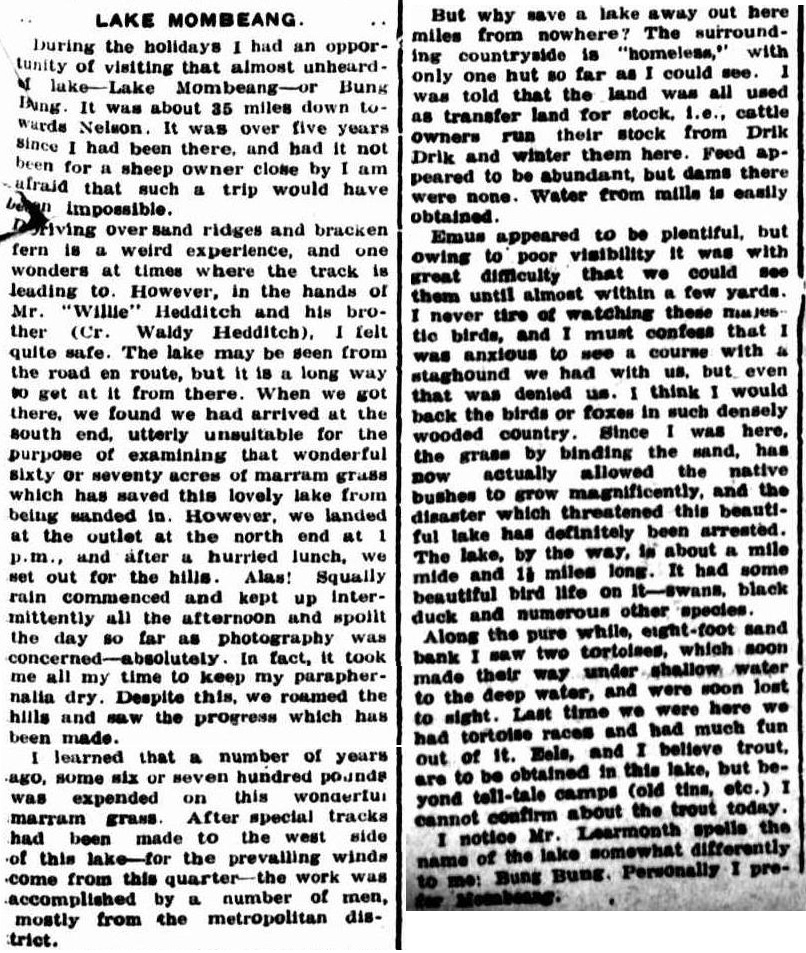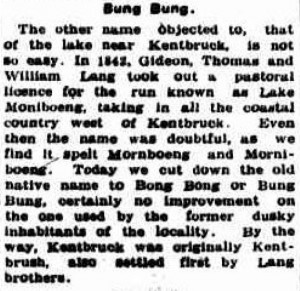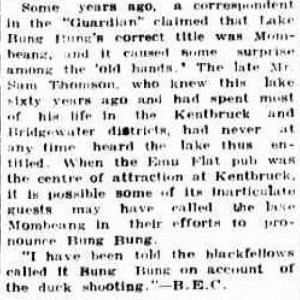Part 3: The Lake Moniboeng Naming Story – The Noel Learmonth review of the 1940s
In the next chapter of this story, we go forward a few years to the mid-1940s.
By this time, it seems that more people were making the journey to what (as we discovered in Part 2) had become known as Lake Bung Bung, a period that also corresponds with an increasing number of natural history observations finding their way into the local paper, the Portland Guardian. This trend was helped along by one of the district’s respected residents, Noel Learmonth (1880 – 1970), becoming a regular contributor. He was an Australian author, sheep farmer, naturalist, historian and ornithologist, who was one of the founding members of the Portland Field Naturalists Club in 1945.
In fact it was in 1945 that the article below written by B. E. Carthew, drew his compatriot from the Club, Noel Learmonth into the naming debate – by stating the name of the lake to be Mombeang (a new spelling!), but also closed out the article by stating that Noel Learmonth himself was known to refer to the lake as Bung Bung at that time.

The article on the 4th of January 1945, by Bertram (Bert) Edwin Carthew, field naturalist and postmaster of the Portland Post Office until his retirement in 1948, kicked off the next round of the naming debate. Also note another reference to the planting of marram grass to stabilise the Discovery Bay dunes, which it was feared would swallow up the lake in their drift.
And so began the next round of debate!
A short time later the newspaper published a short retrospective piece, touching on the use the name Mombeang (a misspelling of William Hedditch’s 1930s Mombeong), and the reaction among the locals to previous articles (probably those same ones we reviewed in Part 2 from the 1930s). It is also interesting to see that the story relayed here about how the name “Bung Bung” came about (quoting Bert Carthew – B.E.C.) has been through its own round of Chinese Whispers – now morphing to become a rather insipid tale of duck shooting – with no mention of the previously reported account of a potential Aboriginal shooting.
Enter Noel Learmonth…
Here we find remarkably that, where others had failed, Noel managed to track down the original Lang run name, of Lake Moniboeng – quite an achievement! He then goes on to speak of the name variants that appear on the 1860s maps which caused him some doubt (noting however that all versions here ended with “boeng”), before lamenting the present (1940s) use of Bung Bung or Bong Bong.

The first submission from Noel Learmonth on the naming issue – 1st February 1945. He came across the original names of the Lang brothers runs: Moniboeng and Kentbrush.
And so began a small mission to correct what Noel saw as a historical inaccuracy. There was only one problem! By the time of his next contribution just two weeks later – his own spelling had changed, with the “oe” becoming an “eo” – and with this simple error, the modern adopted name of Lake Monibeong was born.

In his subsequent offering, on the 15th February 1945, Noel Learmonth slips in his spelling – and Lake Monibeong is born…
In the final article I have found by Noel Learmonth on the lake from 1952 (below), we get a great overview of the story one last time. Noel deals with the local conflicting ideas about the name with logic and the facts he had at hand, giving a sensible explanation for the differing points of view. Once again however the spellings are all over the place (possibly due to poor editorial control), but his preferred nominated name of Lake Monibeong is again stated and spelled the same.
It is interesting to hear yet another account and reason for the name Lake Bung Bung. In this case we hear that early settler Thomas Bilston may have fired on some indigenous people for spearing his cattle. After the series of “whispers” we’ve encountered we could never be sure, but is it possible that this could be the true account that explains the alternative name?

The final reference to Lake Monibeong from Noel Learmonth – several years later on the 10th April 1952 – still looking for correct naming recognition. Note the number of inconsistent spellings in this one article – editorial standards were a bit patchy!
I’m not sure exactly when or how the name changed formally to Lake Monibeong, but I do know Noel Learmonth went on to tell various people of his desire to see the name changed for many years to come. This included government officers (including one young officer at the time Gavin Cerini, who has since relayed his conversations with Noel in the late 1960s about this issue to me), so it obviously got picked up somewhere along the line.
While this was a testament to his perseverance, it does seem ironic that (like William Hedditch in the 1930s) Noel Learmonth didn’t manage to quite push the spelling for the name that stayed true to his own desire for historical accuracy. Having said that, with just two letters around the wrong way, he got a lot closer that others did before him!
In the fourth and final part to this tale – still to come – we’ll review the evidence for determining just how confident we can be that Moniboeng is the historically and phonetically accurate name.


